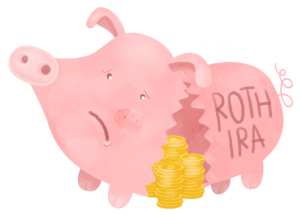
When you imagine retirement, what do you think of? If your answer to that question is anything other than “working as a Walmart greeter,” you’re going to need to start saving.
Luckily for you, it’s never too late to start a retirement account, and there are plenty of options available to you.
If you don’t know, retirement accounts are investments you (or, if you’re lucky, your employer) make that are designed to hold or increase their value over time, so that when you retire, you can live off of regular disbursements from the accounts. Generally they work by investing in mutual funds and offering tax breaks either in the form of upfront tax deductions or tax free disbursements when you retire.
Keep reading for a complete breakdown of all the retirement accounts available to individuals in the US as well as some general heuristics to help you decide which is best for you.

An IRA is an account you contribute to individually (duh) — it doesn’t have anything to do with your employer, and you can choose how much you want to contribute per year, though there are contribution limits.
As of 2023, individuals under the age of 50 can contribute up to $6,500 per year to their individual retirement accounts, whereas those 50 or over can contribute up to $7,000.
There are two different types of IRA which differ in how taxes are assessed to the money deposited into the accounts.
A traditional IRA gives you tax benefits immediately. Money deposited into a traditional IRA can be deducted from your taxable income for the year, which means you’ll have a lower tax liability overall.
The downside here is that, when it comes time to withdraw money from your IRA once you retire, those withdrawals will be taxed like normal income.

A Roth IRA is basically the opposite: you make your contributions after your income is taxed, so you can’t deduct these contributions form your annual taxable income. However, when you retire and begin to withdraw funds from your Roth IRA, those withdrawals will be tax free.
The answer to this question depends on a lot of varying circumstances, most to do with how old you are, when you plan on retiring, and what your current vs. likely future tax bracket will be.
As a general rule, you should expect taxes to go up as you age, and so it’s likely that the “best” decision (i.e. the one that will result in you having the most money total) is to invest in a Roth IRA so you pay taxes when you’re younger and are being taxed less, then enjoy tax free retirement.
Life, unfortunately, is not so simple.
You might be in a situation where the cash back you can get from the tax break for contributing to a traditional IRA could mean the difference between ends meeting or not.
It might also be the case that you’re making more money now than you expect to make in the future, and so the immediate tax savings you’d get from a traditional IRA could outweigh those offered by a Roth IRA.
Ultimately, which account will be best for you is whichever will allow you to live most comfortably now and after you retire.
The best practice, however, would be to speak with a financial professional who can provide tailored advice to your specific situation.
Setting up a traditional or Roth IRA is easy enough that you can do it on your own (although, like we mentioned, speaking with a financial advisor is a good idea just to make sure all your ducks are lining up nicely).
If you’re finance-savvy enough to manage investments on your own (which, given the fact that you’re reading this blog seems just a little unlikely), you can start your own Roth or traditional IRA without even speaking to another human being. You simply navigate to the website of whichever financial institution you want to manage your IRA and follow the steps to create a new account.
Here’s all the information you’ll need on-hand in order to start an IRA:
If you’re closer to novice than expert when it comes to finances, however, you can still start an IRA relatively easily, though you’ll need to speak with someone on the phone. Most of the larger companies that manage retirement accounts (e.g. TIAA or Vanguard) offer advising services which are relatively inexpensive.
Vanguard, for example, charges $30 per year for every $10,000 they manage for you (though it’s worth noting that they require you to have a minimum of $50,000 invested to qualify for their advice).

If you’re lucky, you work for a company that offers employer sponsored retirement plans to its employees. Most of the time, if you have access to an employer sponsored retirement plan, it’s going to either be a 401 (k) or a 403 (b). However, there are a few other options out there we’ll make sure to cover as well.

A 401 (k) is the standard employer sponsored retirement plan in the United States. It allows you to build retirement savings with pre tax dollars so you can invest more than you would be able to if you were working with post tax dollars. Though, when you do begin to take disbursements from your 401 (k) when you retire, those withdrawals count as taxable income.
Here are some of the key features of a 401 (k) plan:
A 403 (b) is basically the same retirement plan as a 401 (k) except they’re for tax-exempt employers (like schools, government agencies, or nonprofit organizations). While there are some differences on the administrative side of things — for example, the rules governing employer contribution limits are slightly different between a 401 (k) and a 403 (b) — as an employee, you’d be unlikely to know the difference between one and the other.
A Simplified Employee Pension is a type retirement plan designed to simplify the process of providing retirement benefits to employees for small business owners and self employed individuals. In terms of how it builds wealth over time and when you pay taxes on the contributions you make, an SEP IRA is functionally the same as a traditional IRA.
So, as an employee, you may not notice the difference between an SEP IRA and a traditional one. As an employer, however, it would be much easier to manage an SEP as opposed to a traditional IRA. This is because, with SEP IRAs, you create a set of qualifications that apply to all employees, and you make the designated contributions for all eligible employees so the administrative lift is much less.
It’s also worth noting that, even if you have a different employer sponsored retirement plan for your primary source of income, you could set yourself up an SEP IRA if you have a side hustle at which you are self employed, like selling Beanie Babies on ebay.
There are a few other key distinguishing features of an SEP IRA.
First, only employers can contribute to these retirement accounts; employees cannot make their own contributions. This means that employers get the tax benefits from contributing to an SEP retirement plan, while employees will have to pay taxes on the income withdrawn post-retirement.
Contribution limits are also much higher than for traditional or Roth IRA accounts. As of 2023, an employer can contribute up to 25% of the employee’s salary or $66,000 per year (whichever is lesser).
These retirement accounts vest immediately for employees, so they own 100% of the account right away. This differs from other retirement savings vehicles which may have a vesting schedule (depending on who your employer is), meaning you would have to work with that employer a certain amount of time before fully owning the contents of your retirement account.
Employers can change the amount they contribute to employees retirement plans on a year-to-year basis. So, if your company has a particularly bad year, they may choose to contribute less to your retirement the following year. Or, if you’re lucky, the opposite could happen: a good year could lead to more retirement savings.

SIMPLE IRAs are designed for small business owners (generally with fewer than 100 employees) who do not currently sponsor traditional retirement plans for their employees. These plans allow both the employer and employees to contribute to retirement savings, like a 401 (k), however there are some differences worth noting.
Employees are not actually required to contribute to their SIMPLE IRA plan. However, employers are. As of 2023, employers using SIMPLE retirement plans are required to contribute either 3% of the employee’s overall salary (if the employee elects to make their own contributions) or 2% of their salary (if the employee chooses not to contribute).
Like with SEPs, SIMPLE IRAs are 100% vested immediately, so employees own all of the funds in these retirement accounts.
Pensions are retirement plans that don’t actually involve retirement savings because they offer a certain level of guaranteed income after retirement. The employee doesn’t own any sort of investment account the success of which might determine how much money they have to retire with, because the amount they receive in retirement is based instead on years of service with the company, their average salary as an employee, and potentially some other small factors.
These days, pensions are somewhat rare as retirement plans go: they’re expensive for employers to maintain and represent a certain amount of risk. Employers still have to pay out agreed-upon pension payments even if the investment accounts that fund those payments aren’t doing so well.
What’s more, pensions are sort of built around the idea that you’ll be working for the same company for your entire career, and so you don’t actually get to reap the benefits of a pension unless you work for the same company for something like 30 years.
These days, when folks change jobs like hermit crabs switch shells, that just doesn’t happen all that often.
If you find yourself working for a company that offers a pension, however, that might be something to consider when deciding if you want to leave for a different job. Having a guaranteed source of income in retirement is a nice weight off your shoulders, and it won’t take any investment on your part (other than sticking around).
We know: that was a lot. Here’s a quick summary of the essentials:
From a user perspective, there are two main ways to break down the various plans for accumulating retirement savings: by the type of tax benefits the account provides and by whether your employer sponsors the retirement plan or not.
Amazing! You should absolutely take advantage of any opportunity you have to pad your retirement savings with free money.
For the vast majority of people, these retirement plans are either going to take the form of a 401 (k) or a 403 (b) (though there are several other options if you happen to work for a small business or are self employed).
What your plan is called, however, is not really that important — it will follow all of the same tax rules we outline in the next section. What does matter are the conditions under which your employer will make contributions to your retirement.
For those with a 401 (k), employers have to option to match contributions or not. Currently, only 56% of employers do this, however, so if yours does, count yourself lucky.
That’s okay. You can still contribute to your own retirement strategically, and have plenty stashed away by the time you’re able to retire to live comfortably.
You’ll have to start and fund your Individual Retirement Account yourself, but doing so is quite easy. There are plenty of large companies who manage IRAs and will even advise your investment choices for a somewhat nominal fee.
The other main consideration when setting up retirement plans is when you want to pay income tax. There are basically two options here: Traditional and Roth.
Traditional retirement plans allow you to deduct contributions from your taxable income that year (this includes employee contributions to employer sponsored plans), however you will have to pay income taxes on the money you withdraw from your account when you retire.
A Roth IRA (or any Roth style account, for that matter) is exactly the opposite. Employee contributions to these accounts are made with money that has already been taxed, so you can’t claim contributions as tax credits to reduce your taxable income now. However, when you retire, you can make withdrawals from your account without paying taxes on that money (because you already paid it).
Generally, if you can afford to, Roth retirement plans will lead to you having more money post-retirement since taxes tend to increase over time and your income also tends to increase over time. By that logic, the taxes you pay on your income when you’re 25 are going to amount to less than those you’ll pay when you’re 55, and so paying your taxes early will save you money in the long run.
Life is rarely so simple, however, and there are plenty of situations in which a traditional account might make more sense for you. You should speak to an investment professional if you have questions about what type of account you should open; they’ll be able to advise you much better than even this excellent and informative blog can.

Back in the day, when most folks stayed at the same job for their entire career, the pension was the most common type of retirement plan in the US. For better or worse, those days have gone the way of the Flowbee (Google it). Now, when many people change jobs more often than Brita filters, most employers that offer benefits for retirement do so in the form of a 401 (k) (or 403 (b) if the employer is a tax exempt entity).
Functionally, a 401 (k) and an IRA are basically the same. The difference is that a 401 (k) is managed by your employer, and they might make certain levels of contributions to the account for you. Obviously, the more money that gets put towards your retirement savings the better, and so a 401 (k) that your employer contributes to is like hitting the jackpot as far as job perks go. As of 2023, only 56% of US employers offer 401 (k) plans to their employees, so if you’re lucky enough to work for one of them, maybe consider sticking around.
Remember the good ole days when retirement meant you stopped working and got to sip daiquiris on the beach for the rest of your life? Alas, things are not so simple anymore. Now, retirement is broken into 3 categories: Traditional, Semi, and Temporary.
This is what you think of when you think of retirement: you stop working and live completely off of social security and retirement savings income.
This is quickly becoming the new standard. For individuals who are of retirement age but don’t have enough retirement income to live without working, semi-retirement is the only option. These folks work part-time to cover gaps in their monthly budget, primarily relying on income from retirement accounts and savings.
This refers to a situation in which a person retires from the workforce for a number of months or years, but ultimately plans to work full time again before retiring permanently.
The 3% rule states that, in order to avoid running out of retirement income before dying, you should never withdraw more than 3% of the value of your retirement portfolio. There are, of course, conflicting opinions on this rule (for example, there is also a 4% rule). Best practice would be to check in with a financial professional prior to (and during) retirement to get advice that will be specific to your exact situation.
YOUR FREE FINANCIAL PLAN
Are you ready to invest in your future?
Build your free plan today.
Start now